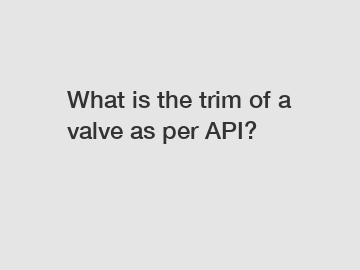What is the trim of a valve as per API?
What is the trim of a valve as per API?
Definition of Valve Trim
Valve trim refers to the internal components of a valve that come into contact with the flow media. This includes parts such as the valve seat, disc, stem, and any additional components that control the flow of fluids through the valve. The choice of valve trim is crucial in determining the performance and functionality of the valve.API Standards for Valve Trim
As per API (American Petroleum Institute) standards, valve trim is classified based on the materials used for construction. API defines different trim materials that are suitable for various operating conditions such as temperature, pressure, and corrosive environments. The selection of valve trim is essential to ensure safety, reliability, and efficiency in valve operations.Step-by-Step Guide for Determining Valve Trim
1. Determine Operating Conditions: The first step is to identify the specific operating conditions of the valve, including temperature, pressure, flow rate, and the type of fluid or gas being handled.2. Refer to API Guidelines: Check the API guidelines and standards to understand the recommended trim materials based on the operating conditions. API provides detailed information on the compatibility of trim materials with different fluids and environments.3. Consider Trim Options: Based on the operating conditions and API recommendations, evaluate the available trim options. Common trim materials include stainless steel, carbon steel, alloy steel, and special alloys like Monel or Inconel.4. Select Trim Material: Choose the trim material that best suits the requirements of the application. Consider factors such as corrosion resistance, erosion resistance, mechanical strength, and compatibility with the flow media.5. Verify Compliance: Ensure that the selected trim material complies with API standards and regulations. Make sure the material is certified for the intended application and meets all necessary requirements.6. Installation and Testing: Once the trim material is selected, install the valve trim according to manufacturer specifications. Conduct thorough testing to verify the performance and functionality of the valve under actual operating conditions.7. Maintenance and Monitoring: Regularly inspect and maintain the valve trim to prevent wear, corrosion, or damage. Monitor the performance of the valve trim to ensure optimal operation and prolong the service life of the valve.By following these step-by-step guidelines, operators can effectively determine the trim of a valve as per API standards, ensuring efficient and reliable valve performance in various industrial applications.If you want to learn more, please visit our website peek ring, surface safety valve actuator, surface safety valve price.



